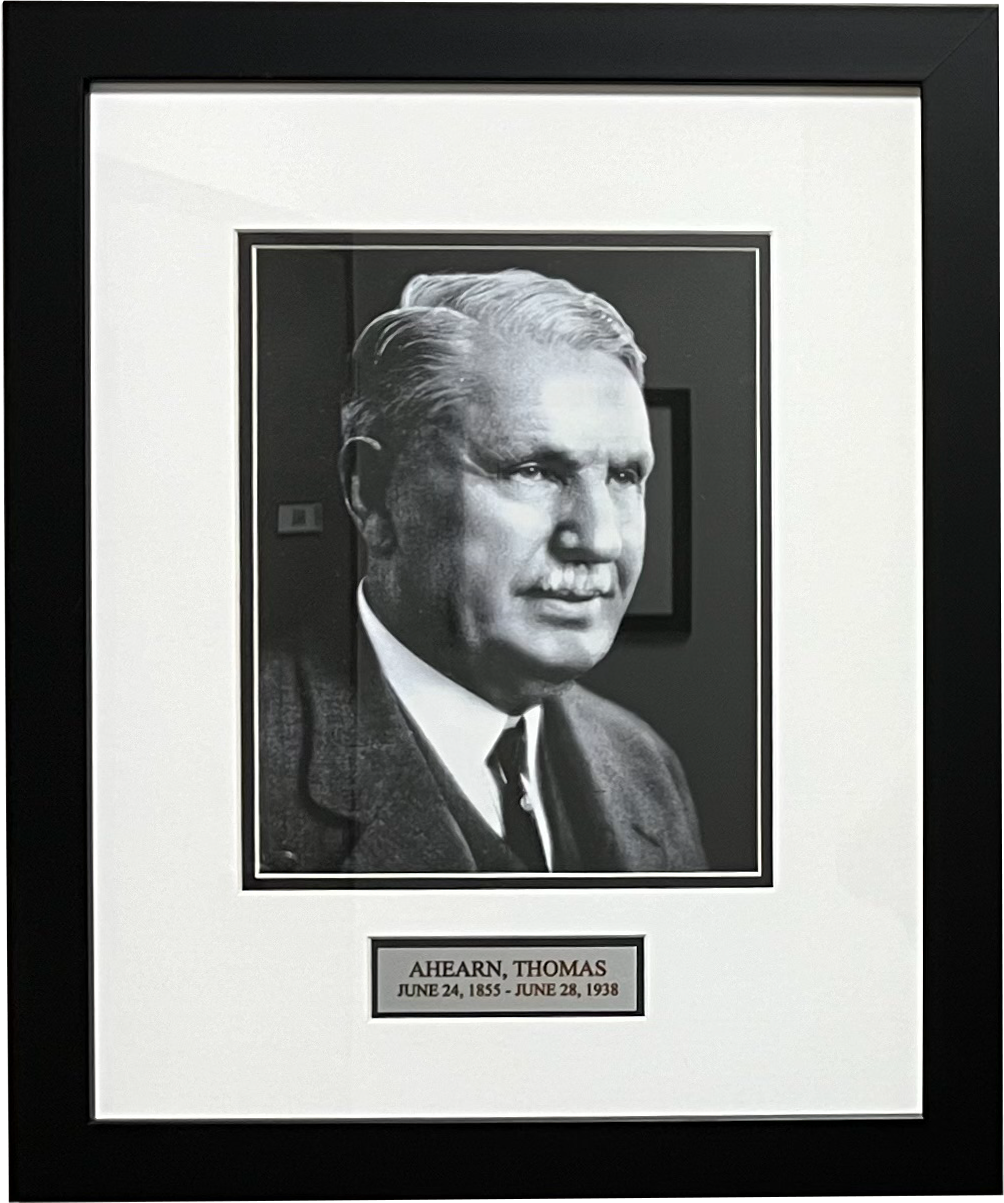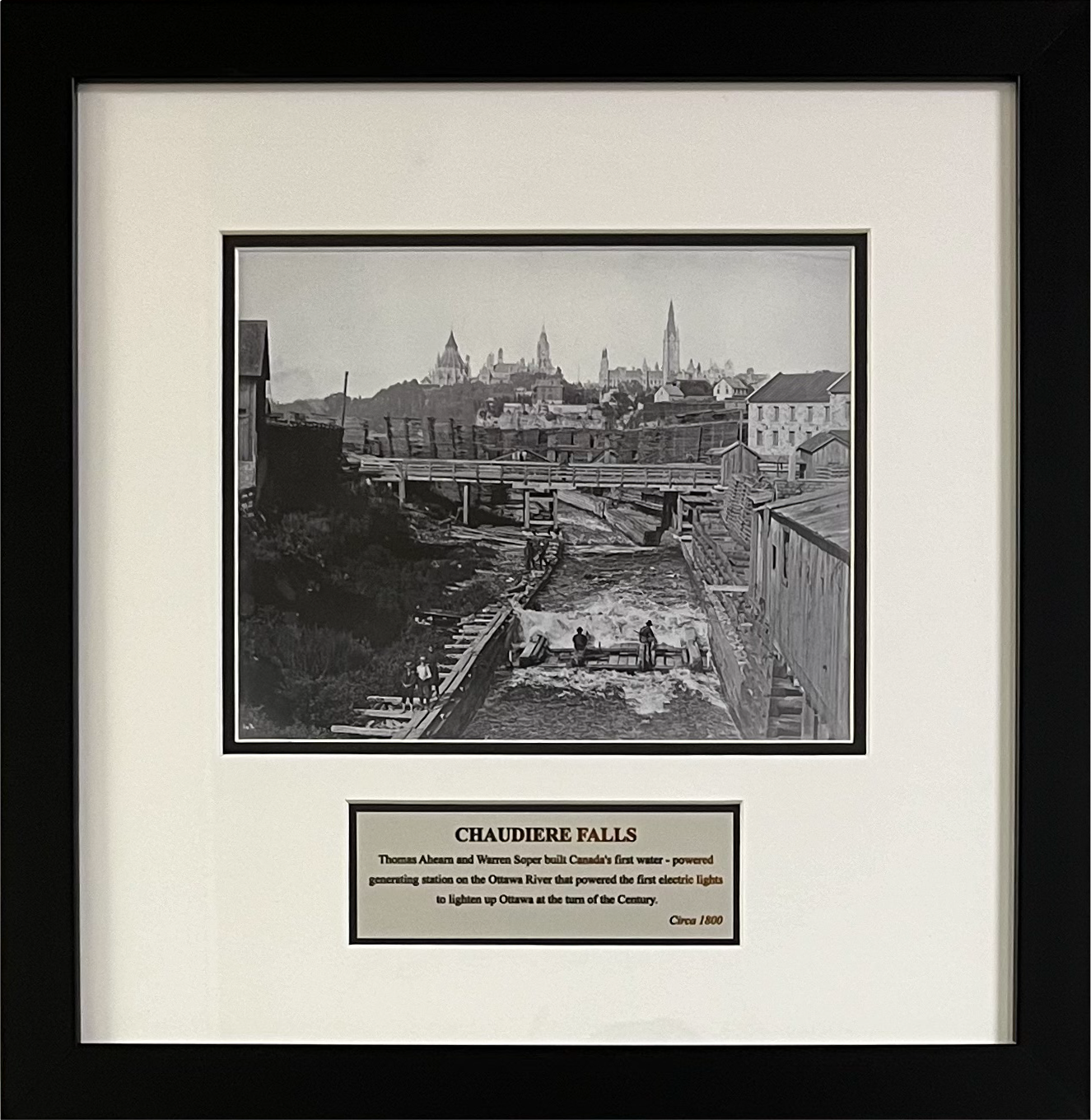Company History
Thomas Ahearn and Warren Soper founded Ahearn & Soper in 1881 to pursue the communications business, pioneering telegraph and telephone devices. Early successes included erecting long distance phone lines for Bell Canada as well as founding and operating several successful companies including Ottawa Light & Power Company, the Ottawa Telephone Company and the Ottawa Street Railway. Thomas Ahearn and Warren Soper are credited with introducing the first all-electric streetcar system to Ottawa.


Thomas Ahearn, born in Ottawa, began his career by joining the JR Booth company to offer his services for free in exchange for a chance to learn the exciting new technology of telegraphy. Warren Y. Soper was born in Maine but came to Ottawa as a small child. They were both expert telegraph operators in Ottawa while still in their teens. Ahearn spent some time with the Western Union Telegraph Company in New York City, then while still very young, was appointed local manager of the Bell Telephone Company in Ottawa. Soper became manager of the Ottawa office of the Dominion Telegraph Company. Their occupations brought them together and in 1881 they resigned their positions and formed a partnership as Ahearn and Soper, Electrical Contactors. They continued to form one innovative company after another in the field of communications, heat, light, power (they became representatives of the Westinghouse Electric Manufacturing company) and the electric street railway.
Ahearn & Soper began by acquiring contracts for and constructing many of the original telegraph and telephone transmission lines in Eastern Canada. Later, the company supplied its own patented station equipment for the first transcontinental telegraph system. As further evidence of its early prominence in the communications business, Ahearn & Soper organized the first all-Canada radio broadcast on Dominion Day, 1927. Later that year, Thomas Ahearn, together with Prime Minister of Justice Ernest Lapointe, made the first trans-Atlantic telephone call to Britain to inaugurate that service.
On October 20, 1890, Ahearn and Soper sent a letter to the city of Ottawa offering to form a local company to construct and operate a streetcar railway. They included a cheque for $5,000. After considerable hesitation, the offer was accepted. The Ottawa Electric Railway (OER) company was formed with Thomas Ahearn as President and Warren Y. Soper, Vice-President. Eight months later, on June 29, 1891, the first small electric cars appeared on Ottawa’s streets.
Streetcars were originally purchased in St. Catharines, Ontario but within a few years Ahearn and Soper started to design, build and repair streetcars and associated equipment at their small company plant called the Ottawa Car Company. The existing horse-drawn cars competed for two years with the Ottawa Electric Railway, and then the company was absorbed by OER. The operations of the company were largely directed from the offices of Ahearn and Soper in Ottawa. The electric cars Ahearn and Soper made were highly regarded and orders came from many outside sources including: Quebec Electric Railway, Three Rivers Traction Company, Oshawa Electric Railway, Port Arthur and Fort William, Winnipeg, Edmonton, Calgary, Regina, Saskatoon, Moose Jaw, Halifax, and St. Johns, Newfoundland (narrow gauge).


The problem of snow threatened to prevent the winter use of streetcars, but the company solved the dilemma by manufacturing a specially-designed electric sweeper in the form of an enormous cylindrical broom which rotated at a high speed. The electric heaters installed in the first electric cars in Ottawa were invented and patented by Thomas Ahearn and manufactured in Ahearn and Soper’s Ottawa factory. This led to Ahearn inventing and patenting “cooking heaters”,now referred to as the electric stove.
In 1947 a proposal was brought forward that the city should purchase the OER company. The purchase went forward and led to the creation of the current Ottawa Transportation Commission (OTC). The OTC started with an initial fleet purchased from the OER of 130 streetcars and 61 buses.
After the streetcar business, Ahearn & Soper was involved with consultative engineering, sales and service on behalf of many renowned manufacturers of electronic equipment. One line of equipment was transmitting devices for long distance communications (klystrons) manufactured by Eitel-McCullough, Inc. Designed for air navigation systems, this solution met system requirements by offering a shaped RF pulse output to eliminate spectrum interference with adjacent channels. Over the next decade, other equipment represented by the company included communication equipment, remote control equipment, secode selectors, signal equipment, morse, telephoto, and facsimile equipment, scatter multiplex communications, measuring instruments, VHF transmitters & receivers and radio transmitting & receiving equipment.
In 1955 Ahearn & Soper received sales authorization from Siemens for telecommunication equipment and scientific instruments. From there, Ahearn & Soper obtained a significant order for the telex switching equipment from CN/CP Communications. These lines eventually connected Canada from the North West Territories, to Victoria, BC, to St. Johns, NF with approximately 50,000 users. Four years after the first Siemens sale, Ahearn & Soper formed a subsidiary in New York and received orders from Western Union for telex switching systems. Siemens X-Ray diffraction units, spectrometers and level meters were also included in the sales program by Ahearn & Soper. In 1959, Ahearn & Soper was also given authorization to distribute Siemen’s electrical power equipment. In 1962 Siemens established its own Canadian operation, and Ahearn & Soper’s association with Siemens came to an end.
In 1961, the company’s last link with its founding families was broken when Harold Soper, the nephew of founder Warren Soper, sold the company to Industrial Wire and Cable, which held it only briefly before passing ownership to the Paul and Zimmerman families in 1962.
For the balance of the 1960’s the company was active in the field of state of the art industrial process data collection and signal processing equipment, providing application engineering expertise to its customers. Ahearn & Soper was a valuable sales outlet for a number of American Manufacturer’s such as Esterline Angus, Philbrick, Fabritek and Federal Scientific.
Towards the end of the 1960’s Ahearn & Soper began supplying digital data collection systems based on early minicomputer technology, with digital tape output. As the demand for minicomputers grew during the 1970’s Ahearn & Soper used its experience and expertise to become a leading vendor and integrator of high performance minicomputer peripherals, such as high capacity disk, tape and printing systems.
In addition to minicomputer peripherals, Ahearn & Soper supplied video and hardcopy terminals. When company management was introduced to the world’s first “daisy wheel” print mechanism in 1973, they realized that this technology offered a threefold performance improvement over IBM’s “Selectric” printer, and was less expensive and more reliable as well. They decided to produce a proprietary “Multiwriter” daisy wheel word processing terminal, which was developed and manufactured in the present day Toronto facility. The Multiwriter was a very successful product for Ahearn & Soper, with units sold from Australia to Denmark, as well as in North America.
The third generation Multiwriter terminal was developed using micro-processor technology. Since Personal Computers had not yet been invented, Micro-processor software was developed with dedicated mini-computer systems, using an extensive library of proprietary software tools. As a result, by the end of the 1970’s Ahearn & Soper possessed a significant software development capability and understood the management of large and complex software projects.
During the 1970s, two relationships were entered into, each of which were to have a significant impact on Ahearn & Soper’s future direction.
The first association was with Versatec, a pioneer in non-impact printing and graphics. Versatecs could plot complicated graphic images many times faster than the conventional pen plotter technology of the day, but because they were “raster” or dot oriented devices instead of “vector” or line oriented like a pen plotter, significant computing resources were required for successful implementation. Ahearn & Soper implemented many plotting systems for customers in CAD, mapping and other imaging applications and established an expertise in Raster Image Processing.
Ahearn & Soper’s Imprint business remained focused on CAD until the mid 1990’s. During this time we were a leading player in the evolution of CAD from a primarily mainframe or minicomputer application to the primarily PC based application it represents today. Ahearn & Soper partnered with AutoDesk, and then with MicroStation to deliver increasingly powerful PC based workstations, and with Houston Instruments and then Encad to deliver cost effective drawing output solutions.
In late 1993, Ahearn & Soper, along with a few other pioneers discovered that Encad’s color ink jet printers, in combination with the right coated media, and the right image processing software could be made to print near photographic quality images, as well as color CAD drawings. By 1994 Ahearn & Soper had developed and began to deliver its “Micro-Sign” turnkey sign and poster printing system. By 1995 the surging growth of this new market for large format digital picture, poster, sign and banner printing had overtaken the CAD business.
The second relationship was with Printronix. The partnership with Printronix began in 1975, and has now continued for over 30 years. Printronix printers were rugged impact line printers. They also used and use a “raster” or dot based technology to print characters, or graphics. Rugged Printronix printers and their graphic output turned out to be an ideal combination for industrial labelling and barcoding applications. In response to the requirements of the market Ahearn & Soper Inc was soon integrating Printronix hardware, special purpose graphic processors and label medias into barcode labelling solutions for its customers. This very successful and early exposure to the world of barcoding encouraged Ahearn & Soper’s management to focus on Automatic ID solutions and technology, thus forming what was then called the “Advanced Bar Code Systems Division”.
Although Ahearn & Soper’s barcode experience started with printers and labels it soon became apparent that the company would have to source many additional technologies, in order to permit it to provide complete solutions to its customers. Ahearn & Soper was able to identify and establish relationships with the foremost vendors in the barcode industry today, at a time when they were all small pioneering start-ups. These companies include such well known names as Printronix, Intermec, Zebra, Symbol (now Motorola) and Welch Allyn (now Honeywell). Ahearn & Soper has emerged from this process with a complete suite of tools from which to build solutions. Throughout the years our knowledge of the technology and applications has deepened and the technical solutions have become more far-reaching, but our data collection systems are still based on a combination of some or all of the following core components of automatic identification technology; Printers, Scanners, Labels, Applicators, Data Terminals/Mobile Computers, Card Products, and Software.
In 1999 Ahearn & Soper brought its label production in-house in order to ensure that we could guarantee to provide our customers with the highest possible level of quality and service, and also to permit us to provide the sophisticated custom label solutions required by many of our customers.
Today, our sales force has all of the technical building blocks, know how, and application experience in 8 core product groups. They are Barcode/RFID Printers, Labels & Ribbons, Automatic Label Applicators, Barcode Scanners/RFID Readers, Mobile Computers/Data Terminals, Data Collection Software, Access Control Systems, and ID Card Printing & Embossing.
